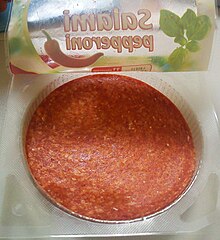Is Pepperoni Usually Made With Beef or Pork
 Packaged pepperoni | |||||||
| Place of origin | United States | ||||||
|---|---|---|---|---|---|---|---|
| Main ingredients | pork and beef | ||||||
| Ingredients generally used | spices | ||||||
| Food energy | 460 kcal (1926 kJ) | ||||||
| Nutritional value |
| ||||||
| |||||||
Pepperoni is an American variety of spicy salami made from cured pork and beef seasoned with paprika or other chili pepper.[1]
Prior to cooking, pepperoni is characteristically soft, slightly smoky, and bright red.[1] Thinly sliced pepperoni is one of the most popular pizza toppings in American pizzerias.[2]
Etymology [edit]
The term "pepperoni" is a borrowing of peperoni, the plural of peperone, the Italian word for bell pepper. The first use of "pepperoni" to refer to a sausage dates to 1919.[1] In Italian, the word peperoncino refers to hot and spicy peppers.
History [edit]
Pepperoni, an Italian-American creation,[1] is a cured dry sausage, with similarities to the spicy salamis of southern Italy on which it is based, such as salsiccia or soppressata. The main differences are that pepperoni is less spicy, has a finer grain (akin to spiceless salami from Milan), is usually softer in texture, and is usually produced with the use of an artificial casing.
Production [edit]
| Nutritional value per 100 g (3.5 oz) | |
|---|---|
| Energy | 1,940 kJ (460 kcal) |
| Carbohydrates | 4 g |
| Fat | 40.2 g |
| Protein | 20.35 g |
| |
| †Percentages are roughly approximated using US recommendations for adults. Source: USDA FoodData Central | |
Pepperoni is made from pork or from a mixture of pork and beef.[3] Turkey meat is also commonly used as a substitute, but the use of poultry in pepperoni must be appropriately labeled in the United States.[4]
Curing with nitrates or nitrites (usually used in modern curing agents to protect against botulism and other forms of microbiological decay) also contributes to pepperoni's reddish color, by reacting with heme in the myoglobin of the proteinaceous components of the meat.[5]
Serving [edit]
According to Convenience Store Decisions, Americans consume 251.7 million pounds of pepperoni annually, on 36% of all pizzas produced nationally.[6] Pepperoni has a tendency to curl up from the edges in the heat of a pizza oven. Some pepperoni is produced in thicker slices, so that the edges curl intentionally.[7]
Pepperoni is also used as the filling of the pepperoni roll, a popular regional snack in West Virginia and neighboring areas.[8]
In the Canadian province of Nova Scotia, deep fried pepperoni served on its own (usually with a honey mustard dipping sauce) is common pub food.[9] [10]
-

Pepperoni on a pizza.
-

A cooked pizza with pepperoni, showing distinct curling and darkening of color.
See also [edit]
- Linguiça
- List of dried foods
- List of sausages
References [edit]
- ^ a b c d Moskin, Julia (February 1, 2011). "Pepperoni: America's Favorite Topping". The New York Times . Retrieved April 22, 2013.
- ^ "America's Most Popular Pizza Toppings". Huffington Post. October 5, 2011. Retrieved April 22, 2013.
According to a survey done by Technomic's MenuMonitor from July to September 2011 based on 235 different pizza places in America pepperoni and plain cheese were the #1 and #2 most popular pizzas ordered.
- ^ Hui, Yiu H.; Culbertson, J. D. (2006). Handbook of Food Science, Technology, and Engineering. CRC Press. p. 72-68. ISBN978-0-8493-9848-3 . Retrieved December 22, 2020.
- ^ Food Standards and Labelling Policy Book, USDA, pp. 133–134.
- ^ Flippone, Peggy Trowbridge. "A Recipe to Make Authentic Homemade Pepperoni". The Spruce . Retrieved December 12, 2017.
- ^ "Pizza Palates Changing". Convenience Store Decisions. June 1, 2009. Retrieved April 25, 2013. [ permanent dead link ]
- ^ López-Alt, J. Kenji (December 2012). "The Food Lab: Why Does Pepperoni Curl?". Serious Eats . Retrieved April 22, 2013.
- ^ Edge, John T. (September 29, 2009). "United Tastes - Pepperoni Rolls, a Piece of West Virginia Culinary History: Fast Food Even Before Fast Food". The New York Times. New York, NY. Style Section: Dining & Wine. Retrieved November 3, 2010.
- ^ Eat This Town (February 1, 2016). "Nova Scotia Food Profiles: Pepperoni". Eat This Town . Retrieved January 7, 2018.
- ^ Brown, Lola (April 2, 2013). "You Must Try: Delicious Deep Fried Pepperoni in Halifax, Nova Scotia". Travel Mindset . Retrieved January 7, 2018.
Further reading [edit]
- Smith, Andrew F. (2007) "Pepperoni". The Oxford Companion to American Food and Drink. p. 447. ISBN 0195307968.
- Palumbo, S. A., et al. (January 1976). "Microbiology and Technology of the Pepperoni Process" (abstract). Journal of Food Science. Volume 41, Issue 1. pages 12–17. (subscription required)
- Palumbo, S. A. et al. (July 1977). "Kinetics of Pepperoni Drying" (abstract). Journal of Food Science. Volume 42, Issue 4. pages 1029–1033. (subscription required)
External links [edit]
-
 The dictionary definition of pepperoni at Wiktionary
The dictionary definition of pepperoni at Wiktionary
Source: https://en.wikipedia.org/wiki/Pepperoni#:~:text=Pepperoni%20is%20an%20American%20variety,paprika%20or%20other%20chili%20pepper.&text=Prior%20to%20cooking%2C%20pepperoni%20is,pizza%20toppings%20in%20American%20pizzerias.
0 Response to "Is Pepperoni Usually Made With Beef or Pork"
Post a Comment